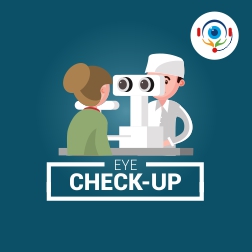Purpose of an Eye Exam
An eye examination aids in assessing vision and whether the function and structure of the eyes possess any kind of abnormalities.
Ophthalmologists and optometrists conduct a physical examination along with a number of tests to check if there are any eye problems. Each individual eye test will analyze various aspects of a person’s vision and eye health.
Eye exams help determine the presence of eye diseases, tumors, potentially blinding diseases and ocular manifestation of systemic diseases.
The amount of time that your eye exam will take will depend on the number of tests that you’re required to take. Following an external examination, you will be asked to undergo any of the following tests -
1. Visual Field Test is performed to help determine peripheral vision by checking if there are blind spots in peripheral vision that result from various eye diseases like glaucoma.
2. Visual Acuity Test is conducted when there is a change or problem with vision by measuring how well an individual can see from near and far distances. 20/20 is the standard visual acuity.
3. Ocular Motility Test is done to understand how well the eyes can follow a moving object. This test checks smooth eye and quick eye movements.
4. Stereopsis Test is conducted to help measure the depth of perception and the appreciation of the three-dimensional nature of objects.
5. Colour Blindness Test is basically a screening test that is carried out to verify if there is colour blindness or not. And if it does exist, the test will help establish the type and severity of the colour blindness.
6. Glaucoma Test is performed by measuring the pressure inside both the eyes. The Puff Off Test is commonly used to calculate the intraocular pressure. A high intraocular pressure reveals a high chance of developing glaucoma.
7. Refraction Test is used to establish eyeglass perception, the level of hypermetropia, presbyopia, myopia and astigmatism.
What should your Routine Eye Assessment include?
1. Individual Health History
2. Family History of Eye Problems
3. Near Vision Test to Determine Presbyopia
4. Test to check the Need for Progressive Lenses
5. Test to check Coordination of Both Eyes
6. Assessing the Optic Nerve and Eye Pressure
7. Test for Cataract & Extraocular Muscle Function
Diagnosis & Treatment
A timely diagnosis will enable early treatment and prevent bigger problems from arising.
Treatment for any existing vision problem or disease will depend on the results of the tests and clinical findings.
Frequency of Eye Exams
The frequency of undertaking eye exams will depend on various factors like age, general health and the risk of developing eye problems; for instance, after turning 55 healthy adults should get their eyes checked once every year.
If you have any of the following vision problems, you will be expected to go for frequent eye checkups as well -
1. Family History of Eye Disorders
2. Glasses or Contact Lens Users
3. Previous Eye Injury / Surgery
4. Diabetics
5. Those Suffering from Systemic Diseases which may affect Vision
6. Those on Medication that may affect the Eyes
Takeaway
Keep up with regular eye checkups to get an update on your eye health.



